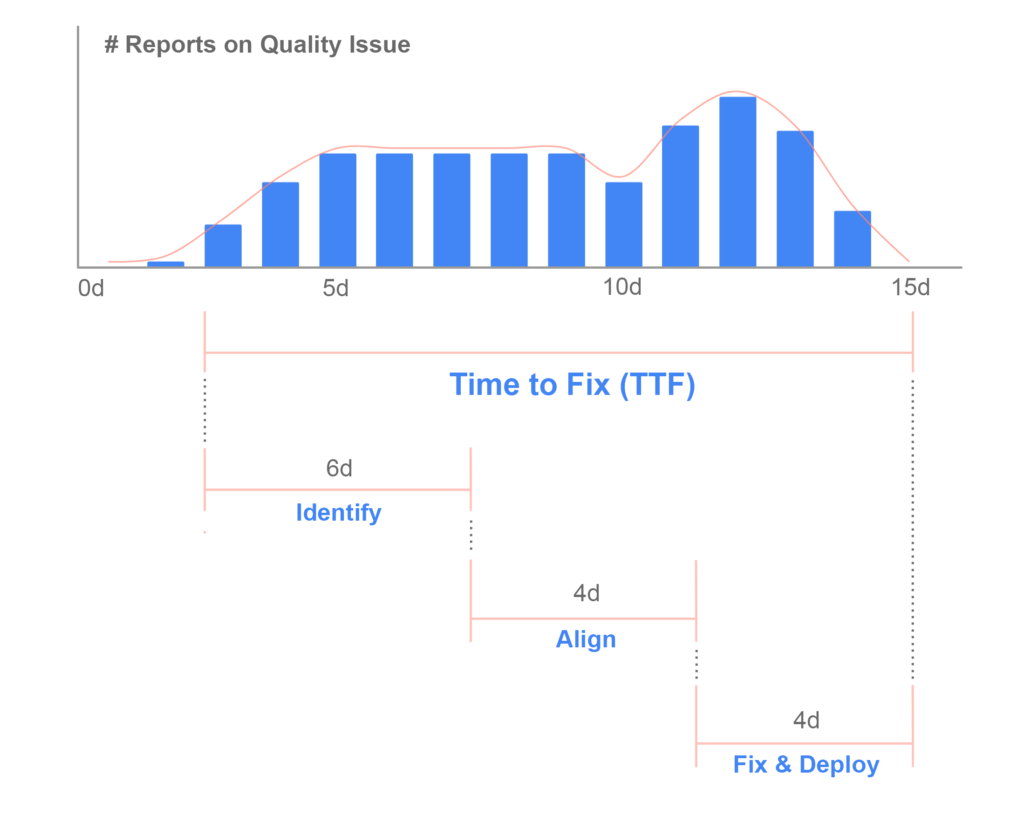The software industry has done an excellent job developing a set of growth metrics: DAU, MAU, DAU/MAU, retention/return rates, and so forth. For product quality or user experience, no one has really developed any metrics, until now. It is very hard to improve what you cannot measure. As a result, we developed two quality metrics: the unitQ Score and unitQ TTF.
unitQ TTF (for Time to Fix) essentially describes how much time it takes for a company to fix an issue in production. A shorter time to fix results in a higher unitQ score, and less time an issue has to impact users, which means fewer tickets to your support team and lower negative sentiment.

unitQ Helps Decrease Your Time to Fix in Three Areas
Issue detection
Alignment among the teams within your organization
Fixing issues

Early detection of quality issues reported by your user base means there is no need to wait until an issue snowballs into a crisis. With unitQ Monitor — our AI-enabled platform that empowers you to take a data-driven approach to identifying, prioritizing, and fixing product quality issues in the most efficient way — you configure alerts to trigger when a specific threshold amount of feedback is crossed, or when the percent change of feedback over a given time period is exceeded. When an alert triggers, it sends a notification to PagerDuty or Slack, so your team knows almost immediately about the issues.
Align: Decisions to deploy resources to fix certain quality issues are made much faster with a Single Source of Truth — data cross-functional teams can understand and rally around.
Typically, different teams in a company may not be looking at the same information. The support team may learn about issues from bug reports, while the marketing team may notice some trends in their social media feeds. unitQ Monitor collects all your customer feedback, from every source — from public sources like app store reviews and social media to private sources like Zendesk or Intercom — into one searchable data store, a single source of truth. Now everyone in your company — from your engineers and support team to the marketing team — armed with this single source of truth can very quickly decide to deploy resources to fix quality issues.
It goes without saying that the more data you have about a problem, the easier it is to fix it. unitQ Monitor provides additional data from a number of sources to help you triage and fix quality issues:
Translated content: All user feedback is translated into English, which can help you fix issues that affect customers in non-English speaking locales.
Custom tags: Add unique labels, categorizations, and other helpful references to any user feedback. If you are using Zendesk, tagging is bidirectional between unitQ and Zendesk.
Metadata like platform, language, country, product version.
Since the engineers tasked with fixing the quality issues have direct access to all this information, as well as a timeline of when they started, the time it takes to reproduce and ultimately fix the bugs contracts significantly.
Conclusion
We have the data to prove the impact of going live with unitQ Monitor. When your unitQ TTF goes down and your unitQ Score goes up, you experience:
Fewer support touches on the same issue over and over, resulting in a top of funnel impact for your support team.
Fewer 1-star reviews and more 5-star reviews.
Increased net sentiment in all user feedback data.
Decreased churn.
Increased engagement and conversion, which ultimately means more revenue!

unitQ Score Improvement

Time to Fix Improvement
Improving your Time to Fix is one way to break the vicious cycle of poor product quality. Keep watching this blog for more tips and tricks on this topic.
And to learn how unitQ is helping category-leading companies like Chime, AppLovin, Pandora, and Strava break out of the vicious cycle, request a demo today.



